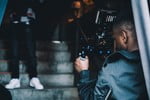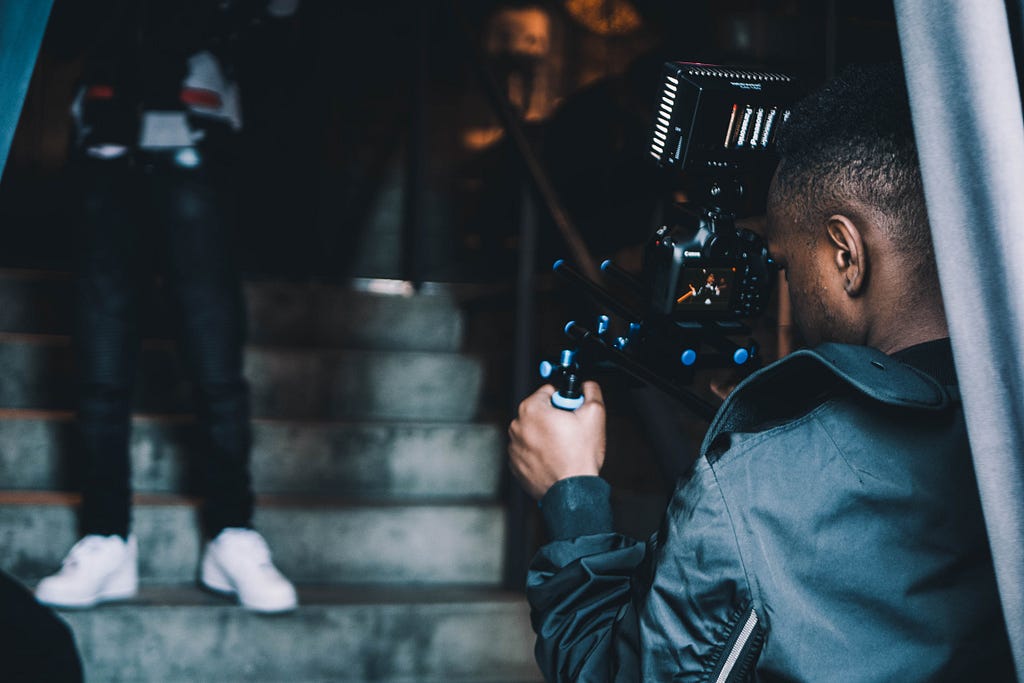
A simple technique that leads to stronger, clearer writing
There are plenty of ways cameras pan in the movies: establishing shots that then zoom in on a detail. Beginning with a detail and zooming out. Staying close and focusing on faces and emotions. A wider shot that shows the scene around characters while they converse. Cutting back and forth between characters while they speak.
What you won’t see, because in cameras it’s nearly impossible, is a jump from the flowerpot on the windowsill to the magnets on the fridge to a person’s hands as they sit on the couch. This would make the viewer so dizzy that it would never happen in the editing room except to intentionally disorient.
Another thing you won’t see? Actions that aren’t in order of when they happened. Imagine you’re watching a movie and you see a character falling down the stairs. Then the next shot is her at the top of the stairs, tripping over a LEGO. Doesn’t make any sense, really, right? The effect should never come before the cause.
This is true when writing, too, although the ways effects sneak in before causes can be tricky at times. I’m not talking about the story itself being in the wrong order (that’s a matter of pacing or plot). I’m talking about sentences.
Sentences are the shots that make up your scene
The order you put your sentences in is, effectively, the cinematography of your writing. The technical term for this order is motivation-reaction units. It doesn’t exactly roll off the tongue, and it sounds complicated, but the idea itself is fairly simple: things should happen in your book in the order they would happen in real life.
To understand this fully, we’re going to take a detour into physiology and psychology. Did you know there’s an order to how your body responds to a trigger? The order has to do with what synapses in your body move fastest. What is subconscious. What is conscious. What takes time. As K.M. Weiland notes,
The first response to a trigger is involuntary and subconscious. You won’t see this. It’s a feeling. A thought. Something that changes inside the person affected.The second response to a trigger is involuntary and physical. A twitch, a flinch, a blush, a gut-wrenching. These are all things that we do, but not with much intentionality.Third comes the voluntary physical movements. Stepping aside. Smiling. Dancing.Finally, is our speech. It doesn’t matter how quick-witted someone is; a dialogue response to a trigger will be last.Training on the film set
Here’s an example of what not to do, one we’ll revise.
When the panther finally jumped out at us, it had been following us for miles. “Look out!” I shrieked, running the other way. My hands trembled and my heart jumped out of my chest. It’s going to kill me.
Let’s analyze this paragraph in terms of its motivation-reaction units.
When the panther finally jumped out at us [cause], it had been following us for miles [something before the cause]. “Look out!” I shrieked [dialogue], running the other way [physical movement]. My hands trembled and my heart jumped out of my chest [involuntary physical movements]. It’s going to kill me [thought].
If we compare that to the order physiology says we respond in, it’s almost completely backward, and it makes the scene feel jarring.
In the editing room
Let’s take it to the editing room, where the order of shots is decided for a movie. I’m going to revise that paragraph so that it follows motivation-reaction units better. Subconscious, then conscious, then spoken.
The panther had been following us for miles, one semi-stealthy step after another, with eyes that shone like beacons when the moonlight hit. I couldn’t walk any longer. The moment I paused, though, the panther leaped from the tree on all fours in front of me, pupils dilated, ready to strike. It’s going to kill me. My hands trembled and my heart pounded wildly inside me. I turned on my heel to run the other way, shouting at my friends still the length of a football field behind me. “Look out!”
See how the order works better now? The panther following the main character comes before the panther jumping in front of them, which makes the first half of the paragraph chronological. Then the reaction is in order: thought, visceral reaction, physical decision, dialogue. Putting it in order doesn’t make that character’s choice any smarter (please don’t run and shout if a panther jumps in front of you), but it is easier to follow.
Varying shots makes good cinematography
As important as it is to show things in the right order, that revision led to something else, too. The whole thing changed when I intentionally revised for cause/effect. Simply rearranging the sentences I originally wrote wouldn’t have made sense, so I thought about the bridges I could build between cause and effect. How I could make one sentence lead into another. Without trying to fix anything but the order, I ended up with a deeper point of view and a more interesting description.
Fringe benefits and all that.
It is also easier to follow the camera movement through that scene. The wide-angle shot with the panther and the point of view character both in the frame. Cut in close to the panther’s eyes before the attack, then close to the character, before zooming out again (or moving quickly the opposite way) through the forest.
Getting behind the camera
Good writing is good revising. It always has been and always will be. Motivation-reaction units give you a template for the order to present information to a reader, to make sure that cause and effect don’t get conflated. It helps guide us through how a scene unfolds, without any breaks in logic, and with a cinematic feel to the actions we present to a reader.
If a paragraph you’re working on just doesn’t seem to flow, “watch” the story you wrote, one sentence at a time. Take it apart and look at the shots of the scene. Are they in order? How does the camera pan? Is the effect before the cause?
When you’re trying to figure out what to leave on the cutting room floor in your writing, thinking about camera pan can make a major difference: to your believability, to the quality of your writing, and even to deepening the point of view.
Camera Pan: The Trick I Borrow from Movies to Revise My Scenes was originally published in The Writing Cooperative on Medium, where people are continuing the conversation by highlighting and responding to this story.
Read more: writingcooperative.com
